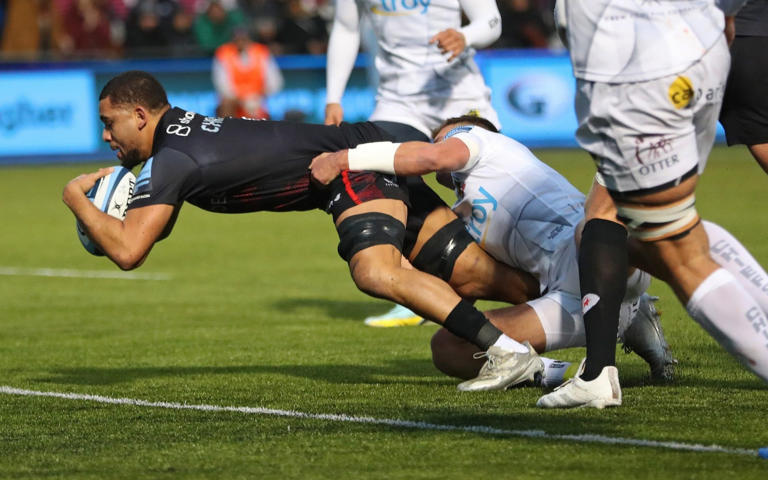In between the second and third of Northampton Saints’ six tries in their 46-17 win over Harlequins at Franklin’s Gardens on Sunday afternoon, tapped a moment stood out from the rest of the hosts’ performance.
Alex Waller stood over the ball five meters from a penalty. The referee, Luke Pearce, warned the close support players to avoid binding onto the carrier by forming a flying wedge. Waller tapped and drove at the line with that in mind.
Throughout the remainder of the game, the Saints bravely moved the ball and tortured their tired opponents.
They paid the price for being direct here. Archie White and Tom Lawday, two tacklers, went low. Alex Dombrandt, a third, went after the ball. He fell backward into the dead-ball area after taking on Waller’s weight:
Previously, Northampton had a five-meter scrum in this scenario. Harlequins would have a goal-line drop-out as a result of relatively new laws that were introduced at the beginning of the previous season. Saints would suffer about 40 meters more.
With deception and complexity, this change will have contributed to a recent rash of penalty moves designed to create mismatches at close range and prevent carriers from being engulfed by defenders. Saracens had joined in to propel their victory over Exeter Chiefs last weekend, roughly 24 hours before Waller was held up by Dombrandt.
Craig Maxwell-Keys actually starts the sequence by giving Owen Farrell a choice. Saracens can start with a breakdown penalty under the posts or a lineout penalty closer to the touchline:
Jamie George nods in agreement with the proposal before Farrell appears to turn to Mako Vunipola. They move out into the open, leaving behind Exeter’s posts:
Farrell hands Mako Vunipola the ball after he shapes to dink into the corner for a lineout, and Saracens take a very deliberate shape.
Marco Riccioni and Maro Itoje are flanking Mako Vunipola, who is over the ball. Jackson Wray is in front of them. A second three-man arrowhead with Jamie George, Billy Vunipola, and Nick Isiekwe is visible above that. Andy Christie is the central figure.
With Mako Vunipola’s pod and Billy Vunipola and Isiekwe as live options for a tip-on pass, Saracens pose a direct threat, but Christie’s off-the-ball movement brings in one more concealed runner. Take note of Joe Simmonds’ and Henry Slade’s starting positions on Exeter’s defensive line:
With Christie taking the place of a deeper distributor, two passes create enough space for the scoring in a pattern that is similar to the phase shape that might be seen in open play. After a pass from Mako Vunipola to Billy Vunipola gets around a crowded group of Exeter defenders, a second pull-back from behind Isiekwe lets Christie curve into a hole because Joe Simmonds bites on Isiekwe. Watch everything over again:
The Saracens head coach stated, “I’ll be honest with you, Mark McCall has been talking about us having something up our sleeve for a long time.” He will resent me for suggesting that he should receive the credit, but basically, on Monday, he came in and said, “This is what you’re doing.” Additionally, it worked, so who knows what will transpire next week.
To bastardize a quote from Mark Twain, you will frequently hear it said that there are no new ideas in rugby union—only old ones that go through a kaleidoscope and come back into fashion with fancy names. Now, imitation is the highest form of flattery, and you will frequently hear it said that there are no new ideas in rugby union. Leinster will have known about the Saracens’ activities.
Josh van der Flier bent over after running the Christie angle during their comprehensive victory over Racing 92 last month.
Caelan Doris is the pivot, and the only obvious difference between him and Billy Vunipola is that he moves his body in a different direction. The same overarching objective is to break through a crowded goal-line defense:
Benetton in Italy has also used a strategy similar to this one. On the big stage of the Premiership final last season, Leicester used a strategy similar to this one to great advantage in the lead-up to Jasper Wiese’s try.
On the Thursday prior to the final, Richard Wigglesworth, who is now Leicester’s interim head coach but was previously the club’s player-coach, had proposed the idea to Steve Borthwick. Ellis Genge took a penalty kick and gestured as if he were running infield before heading wide. Wiese then crashed into Wigglesworth’s pass and scored on the next phase.

